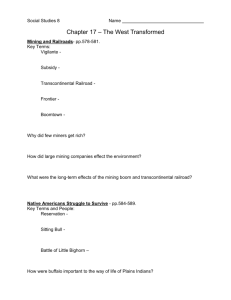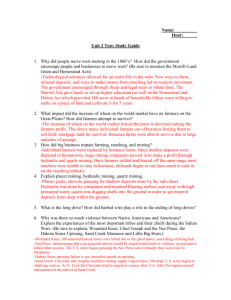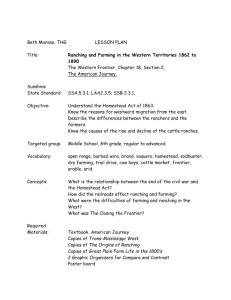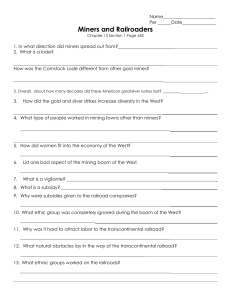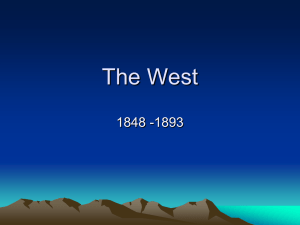File
advertisement
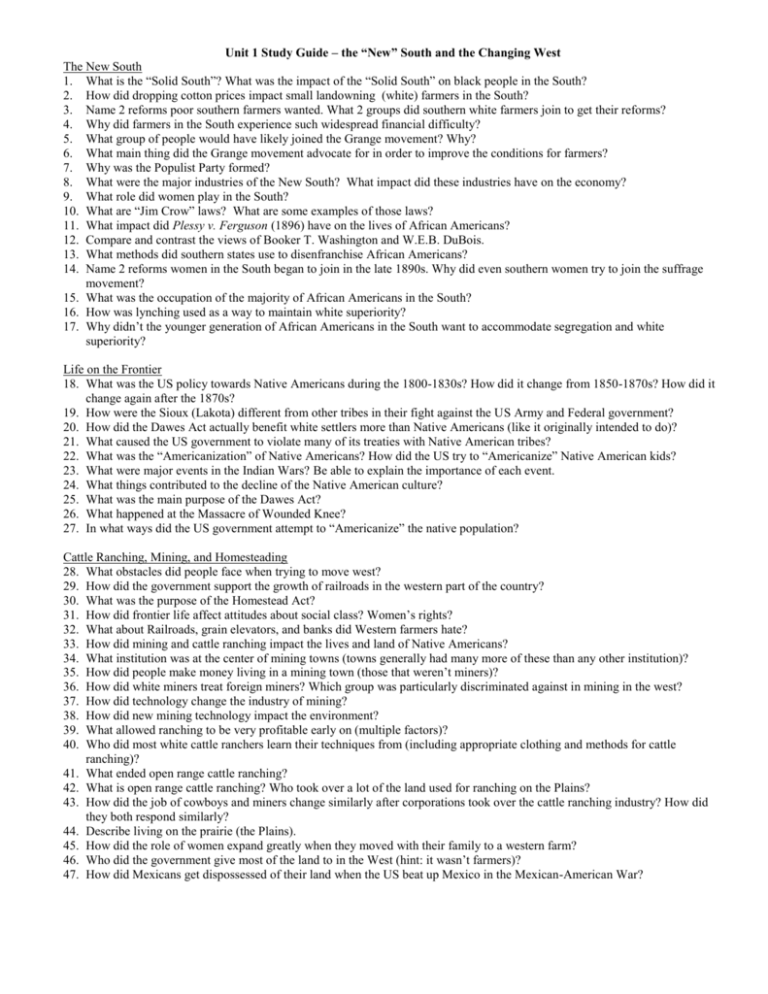
Unit 1 Study Guide – the “New” South and the Changing West The New South 1. What is the “Solid South”? What was the impact of the “Solid South” on black people in the South? 2. How did dropping cotton prices impact small landowning (white) farmers in the South? 3. Name 2 reforms poor southern farmers wanted. What 2 groups did southern white farmers join to get their reforms? 4. Why did farmers in the South experience such widespread financial difficulty? 5. What group of people would have likely joined the Grange movement? Why? 6. What main thing did the Grange movement advocate for in order to improve the conditions for farmers? 7. Why was the Populist Party formed? 8. What were the major industries of the New South? What impact did these industries have on the economy? 9. What role did women play in the South? 10. What are “Jim Crow” laws? What are some examples of those laws? 11. What impact did Plessy v. Ferguson (1896) have on the lives of African Americans? 12. Compare and contrast the views of Booker T. Washington and W.E.B. DuBois. 13. What methods did southern states use to disenfranchise African Americans? 14. Name 2 reforms women in the South began to join in the late 1890s. Why did even southern women try to join the suffrage movement? 15. What was the occupation of the majority of African Americans in the South? 16. How was lynching used as a way to maintain white superiority? 17. Why didn’t the younger generation of African Americans in the South want to accommodate segregation and white superiority? Life on the Frontier 18. What was the US policy towards Native Americans during the 1800-1830s? How did it change from 1850-1870s? How did it change again after the 1870s? 19. How were the Sioux (Lakota) different from other tribes in their fight against the US Army and Federal government? 20. How did the Dawes Act actually benefit white settlers more than Native Americans (like it originally intended to do)? 21. What caused the US government to violate many of its treaties with Native American tribes? 22. What was the “Americanization” of Native Americans? How did the US try to “Americanize” Native American kids? 23. What were major events in the Indian Wars? Be able to explain the importance of each event. 24. What things contributed to the decline of the Native American culture? 25. What was the main purpose of the Dawes Act? 26. What happened at the Massacre of Wounded Knee? 27. In what ways did the US government attempt to “Americanize” the native population? Cattle Ranching, Mining, and Homesteading 28. What obstacles did people face when trying to move west? 29. How did the government support the growth of railroads in the western part of the country? 30. What was the purpose of the Homestead Act? 31. How did frontier life affect attitudes about social class? Women’s rights? 32. What about Railroads, grain elevators, and banks did Western farmers hate? 33. How did mining and cattle ranching impact the lives and land of Native Americans? 34. What institution was at the center of mining towns (towns generally had many more of these than any other institution)? 35. How did people make money living in a mining town (those that weren’t miners)? 36. How did white miners treat foreign miners? Which group was particularly discriminated against in mining in the west? 37. How did technology change the industry of mining? 38. How did new mining technology impact the environment? 39. What allowed ranching to be very profitable early on (multiple factors)? 40. Who did most white cattle ranchers learn their techniques from (including appropriate clothing and methods for cattle ranching)? 41. What ended open range cattle ranching? 42. What is open range cattle ranching? Who took over a lot of the land used for ranching on the Plains? 43. How did the job of cowboys and miners change similarly after corporations took over the cattle ranching industry? How did they both respond similarly? 44. Describe living on the prairie (the Plains). 45. How did the role of women expand greatly when they moved with their family to a western farm? 46. Who did the government give most of the land to in the West (hint: it wasn’t farmers)? 47. How did Mexicans get dispossessed of their land when the US beat up Mexico in the Mexican-American War? Unit 1 Key Terms – the “New” South and Changing West The New South “New” South Sharecropping Populist Party Atlanta Compromise Speech Southern Farmers’ Alliance Colored Farmers’ Alliance The Grange Agrarian Revolt Solid South Jim Crow Laws Lynching New South Plessy vs. Ferguson (1896) White Supremacy Booker T. Washington Ida B. Wells W.E.B. DuBois The Crisis Souls of Black Folk Southern Industrialization American Tobacco Company James B. Duke Tuskegee Institute Populist Party Women’s Christian Temperance Union De jure segregation De facto segregation West Native Americans Indian Wars Federal Indian Policy in 1800s Lakota/Sioux Sand Creek Massacre (1864) Second Treaty of Fort Laramie (1868) Transcontinental RR Battle of Little Bighorn (1876) Ghost Dance Movement Massacre at Wounded Knee (1890) “Americanization” Indian Boarding Schools Carlisle Indian School Dawes Act (1887) Geronimo Chief Joseph Colonel George A. Custer John Chivington Mining and Cattle Ranching Saloons Mining Towns Hydraulic Mining Hard-Rock Mining Abilene, Kansas Chisholm Trail Costs of early cattle ranching Industrialization of Mining Unionizing of miners and cattle ranchers Corporate Takeover of Cattle Ranching and Mining Environmental impact of mining and cattle ranching Barbed Wire Open Range Cattle Ranching End of the Open Range Homesteading Prairie Homestead Act (1862) Morrill Act (1862) Sod Houses Exoduster Challenges of being a Homesteader Roles of women on the prairie Farming on the prairie Economic Hardships of farming in the West Challenges of Banks, Grain Elevators and RR

